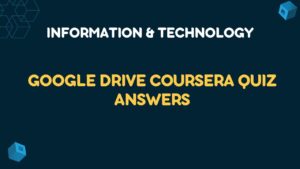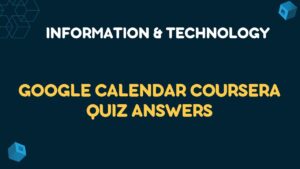Table of Contents
Introduction to NoSQL Databases Week 01 Quiz Answers
Graded Quiz 01: Basics of NoSQL
Q1. What common trait does the NoSQL family of databases share?
- Non-relational
- Technology
- Exclusion of SQL
- Tabular style
Q2. What may be the most common reason to use a NoSQL database?
- Availability
- Consistency
- Scalability
- Security
Q3. What makes Key-Value NoSQL databases powerful for basic CRUD operations?
- They are represented as a hashmap.
- The value blob is opaque.
- They are atomic for key operations.
- They shard easily across nodes.
Q4. Which use case would be a poor choice for a document type NoSQL database?
- Online blogging
- Event logging for a process
- Operational data sets for a web app
- Aggregate-oriented design
Q5. What is a characteristic of column-based NoSQL databases?
- Rows in column families can share all, a subset, or none of the columns.
- Rows in column families are required to share the same columns.
- Columns are grouped together in families because they are often accessed individually.
- Rows in column families share a common key or identifier.
Graded Quiz 02: Working with Distributed Data
Q1. Which industry will almost exclusively use ACID databases?
- Financial institutions
- Ecommerce
- Online social networks
- Marketing consultants
Q2. What is data sharding?
- Replicating data across multiple nodes
- Retrieving data from a failed node
- Fragmenting data into smaller pieces
- Deleting all data and schema
Q3. How many of the desired characteristics of the CAP Theorem can a distributed system guarantee?
- Three
- Two
- One
- None
Q4. What drives your data model in NoSQL?
- How the data is denormalized
- How the data is stored in one or more tables
- The choice between availability and consistency
- Your queries and the way the app accesses the data
Introduction to NoSQL Databases Week 02 Quiz Answers
Graded Quiz 01: Basics of MongoDB
Q1. ___________ provided by MongoDB means as your data needs grow, you can introduce bigger, faster, and better hardware, and partition your data.
- Scalability
- Flexibility
- Self-management
- High availability
Q2. MongoDB is schemaless. What does that mean?
- That you can only store structured data in MongoDB.
- With MongoDB, you don’t need to alter your tables to store additional fields.
- MongoDB does not require that you create the schema and the table structures before writing the data.
- The schema is already created, so all you need to do is to create the table structures that will hold your data.
Q3. True or False: MongoDB follows a code-first approach, which means you can start writing your data as soon as you connect to the database.
- TRUE
- FALSE
Q4. Typical MongoDB setups are a three-node replica set. The ________________ process keeps a copy of your data on the primary node on the other data bearing nodes in the cluster.
- Aggregation
- Redundancy
- Replication
- Clustering
Q5. The “Many Sources One View” use case of MongoDB suggests that __________
- MongoDB can store data that is of different types and formats.
- MongoDB can ingest different types of data from different sources and consolidate it into one view for all data.
- MongoDB can store data collected from multiple sources as long as they are the same format.
- MongoDB can collect vast amounts of data.
Graded Quiz 02: Getting Started with MongoDB
Q1. True or False: Mongo shell is a tool provided by MongoDB to interact with your databases.
- TRUE
- FALSE
Q2. MongoDB uses compound indexing. What is special about a compound index?
- MongoDB compound indexes are used for your most frequent queries by default.
- MongoDB compound indexes are special data structures storing both the fields you are indexing and the location of the document.
- MongoDB compound indexes index more than one field.
- MongoDB compound indexes help quickly locate data without looking for it everywhere.
Q3. Aggregation pipeline is a series of operations that you apply on your data to get a desired result. What does the following operation do?
> db.courseResults.aggregate([
{ $match: { “year”: 2020 } },
{ $group: { “_id”: “$courseId”, “avgScore”: { $avg: “$score”} } }
])
- Filter 2020 documents, group these documents by course, then calculate the average student score per course in that year.
- Filter 2020 documents, group these documents by course, and display the resultant list as an outcome.
- Filter 2020 documents, group these documents by course, then display the student id, course id, and average score of all 2020 documents in a tabular format.
- Filter 2020 documents, group these documents by average score, and display this list in ascending order of average scores.
Q4. A MongoDB Replica Set is a collection of data bearing nodes _________________
- With each node being either a primary node or a secondary node, and each maintaining a copy of the same data through replication.
- With each node being a secondary node maintaining a copy of the same data through replication, so that if you accidentally delete your database you can recover the database from one of the secondary nodes.
- With each node maintaining a copy of the same data through replication, and serving as a backup in case of server hardware fails.
- With each node being a primary node maintaining a copy of the same data through replication.
Q5. What does the following operation in Python do?
customers.count_documents({“lastName”: “Smith”})
- It returns the first document in natural order (the order in which the database refers to documents on disk), which has lastname as “Smith”.
- It allows you to insert the column ‘customers_list’ in the database.
- It counts the number of customers with lastname “Smith” and returns the number of records found as an outcome.
- It updates the customer list with customer information in the ‘customers_list’ field.
Introduction to NoSQL Databases Week 03 Quiz Answers
Graded Quiz 01: Cassandra Basics
Q1. Cassandra is a best fit for use cases that have which characteristic?
- Always available
- Focused on search
- Read with indexes
- Very specific
Q2. What does data distribution start with?
- A token
- A key value hash
- A query
- A data set
Q3. What is a consequence of Cassandra’s availability?
- Possible inconsistency of the changed data
- Strong consistency
- Irresolvable data conflicts
- Little to zero consistency
Q4. What are two logical entities in the Cassandra data model?
- Tables and keyspaces
- Keyspaces and schemas
- Keyspaces and primary keys
- Tables and definitions
Q5. Which guideline should you follow for modeling data?
- Build a primary key that allows you to minimize the number of partitions read in order to answer a certain query
- All of the above
- Build a clustering key that helps you reduce the amount of data that needs to be read by ordering your clustering key columns according to your query
- Choose a partition key that starts answering your query but that also spreads the data uniformly around the cluster
Graded Quiz 02: Working with Cassandra
Q1. Which CQL data type is typically used to store an image or audio?
- Sets
- Bigint
- Maps
- Blobs
Q2. Which command would you use to add new columns to a table schema?
- DROP TABLE
- ALTER TABLE
- TRUNCATE TABLE
- CREATE TABLE
Q3. What does introducing IF in INSERT and UPDATE statements make possible?
- Attaches a Timestamp to a specific write operation
- Instructs Cassandra to look for the data, read it, and only then perform a given operation
- Creates a new file called SSTable
- Inserts/updates data with a specific Time-To-Live
Q4. What is a difference between CQL and SQL?
- Intuitive and simple syntax
- Support of JOIN statements
- Syntax that allows the creation of tables and keyspaces
- Syntax that allows the creation of inserts, deletes, and select queries
Q5. What does DROP KEYSPACE remove?
- All data and schema
- All keyspace table data
- All data and primary keys
- All keyspace tables and their data
Introduction to NoSQL Databases Week 04 Quiz Answers
Graded Quiz 01: Cloudant Basics
Q1. Which IBM Cloudant capability helps you most to develop custom apps?
- Language-specific libraries
- Data replication
- Offline First
- Geospatial GeoJSON
Q2. How are IBM Cloudant users routed to data centers?
- Ping timing
- Geographic load balancing
- MapReduce
- Replication protocol
Q3. What are the two primary reasons that documents are organized into databases in IBM Cloudant?
- For querying and clustering
- For scaling and security
- For security and querying
- For querying and schema flexibility
Q4. With which IBM Cloudant deployment option plan is there a maximum limit of 1MB for a single JSON document?
- Lite Plan
- Standard Plan
- All of the above
- Dedicated Hardware Plan
Q5. Which IBM Cloudant technology would work best for applications involving oil, gas, or transportation?
- Full-text Search
- Geospatial
- Operational datastore
- MapReduce
Graded Quiz 02: Working with Cloudant
Q1. Which option will most likely increase the cost to an organization running multi-tenant instances of IBM Cloudant?
- Continuous replication
- One-time replication
- Compaction
- Indexing
Q2. When you use the name of a variable in a curl command, which character must precede the name of the variable?
- #
- v
- $
- @
Q3. What should you use to help you to get the best long-term performance out of your IBM Cloudant databases?
- Indexing
- Continuous replication
- Partitioned databases
- Non-partitioned databases
Q4. Which HTTP method is the default for curl?
- GET
- POST
- -X PUT
- PUT
Q5. What is the maximum size for a Cloudant document JSON object?
- 5 megabytes
- 1 megabyte
- 100 megabytes
- 10 megabytes
Get all Course Quiz Answers of IBM Data Engineering Professional Certificate
Introduction to Data Engineering Coursera Quiz Answers
Python for Data Science, AI & Development Coursera Quiz Answers
Introduction to Relational Databases (RDBMS) Quiz Answers
Databases and SQL for Data Science with Python Quiz Answers



